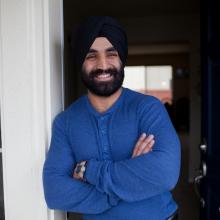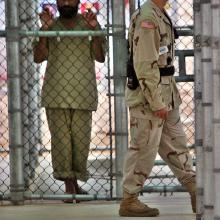army
A neo-Nazi had walked into a gurdwara — or Sikh temple — in Oak Creek, Wis., and gone on a rampage, fatally shooting six worshippers and wounding several others, including a police officer. To this day, the attack on the Oak Creek gurdwara remains one of the deadliest acts of violence on an American house of worship in our nation’s history.
A year and a half after joining the Air Force, Ofir is halfway through her stint as a flight simulator instructor. Despite the rigors of military life she continues to keep kosher and observe the Sabbath.
Ofir is one of a growing number of Orthodox Jewish women who see no contradiction between serving in the military and maintaining a religious lifestyle – a trend that some Israeli rabbis hope to end.
New Army regulations will allow soldiers to wear turbans, beards and hijabs under most circumstances, reflecting a change Sikhs have sought for years.
“Based on the successful examples of Soldiers currently serving with these accommodations, I have determined that brigade-level commanders may approve requests for these accommodations,” wrote Secretary of the Army Eric K. Fanning in a Tuesday (Jan. 3) memo.
In March, the Army concluded that permitting beards for medical reasons but banning them for religious reasons is a discriminatory bar to service for Sikhs, who are forbidden by their faith to cut their hair and beards.
We write to you on All Saints Day to update you on the situation in Iraq. Remembering the Christians who were killed in 2009 while attending Mass at Our Lady of Deliverance Church in Baghdad. That was the beginning of harder times to all Christians in Iraq.
It has been two years and four months since we left Nineveh Plain. It has been long time of displacement, of humiliation, of exile. However, people always lived in hope of God’s mercy to return and go back home. We believed that God will not fail us.

Image via U.S. Army Capt. Simratpal Singh / The Sikh Coalition / RNS
A decorated veteran Sikh officer is the first to win an approval from the U.S. Army to continue on active duty while maintaining his religiously mandated beard and turban. The Army issued a decision March 31, concluding that to allow beards for medical reasons but ban them for religious reasons is a discriminatory bar to service for Sikh Americans, according to a statement from the Becket Fund for Religious Liberty, one of the law offices that argued his case.

Image via REUTERS / RNS
How far does the U.S. military have to go to provide religious accommodations for locked-up al-Qaida terrorism suspects?
That’s the question before a military judge who is weighing whether female guards should be banned from touching detainees at Guantanamo Bay, Cuba.
Five of the military’s “high-value” detainees asked the judge Oct. 30 to permanently forbid women guards from touching the prisoners. Their Muslim traditions, they say, prohibit women other than their wives or relatives from touching them.
But the two female guards who sometimes shackle or escort the detainees say a ban on touching violates their equal employment rights. They have won support from members of Congress and the Obama administration who called the ban “outrageous.”
Chaplains who are part of the Army’s first line of defense against suicide say they need more training in how to prevent soldiers from killing themselves, according to a Rand Corp. survey published online April 7.
Nearly all the chaplains and chaplain assistants surveyed said they have dealt with suicidal soldiers, and most said they encourage troubled soldiers to get help. Because of confidentiality, roughly half said they would be reluctant to alert someone in the chain of command about the soldier, and roughly a third said they would not call a crisis hotline for the GI.
In addition, the study found that chaplains and chaplain assistants hold some of the same negative views about therapy that often discourage soldiers from seeing a behavioral health specialist. Most in the survey agreed that service members who seek help for suicidal thoughts would be seen differently by their peers. About half said they would be embarrassed.
Researchers said they believe this may be why chaplains are reluctant to intervene when a soldier comes to them with signs of suicidal thinking.
AS A FORMER reserve police officer who has taught ethics at two police academies, I followed the news very closely after 18-year-old Michael Brown was shot to death by police officer Darren Wilson in nearby Ferguson, Mo. When I saw the military equipment of the St. Louis County Police—especially the sharpshooter on top of an armored vehicle aiming his rifle at the protesters—I said to my wife, “This may turn out to be very, very bad.”
Sen. Claire McCaskill argued in the midst of the protests that St. Louis County should “demilitarize the police response” in Ferguson, telling reporters, “The police response has been part of the problem.”
The militarization of police has been trending over the past few decades. When the thin blue line resembles an occupying force, it exacerbates racial tensions in neighborhoods and communities, making things worse for everyone, including the police.
Some communities are starting to push back. For instance, the city council of Davis, Calif., recently directed its police department to get rid of a mine-resistant, ambush-protected vehicle (worth $700,000) that it had received free from the U.S. military’s surplus program.
More than two years after first making his request, Army Maj. Ray Bradley can now be known as exactly what he is: a humanist in the U.S. military.
Lt. Col. Sunset R. Belinsky, an Army spokeswoman, said Tuesday that the “preference code for humanist” became effective April 12 for all members of the Army.
Catholic military chaplains cannot be forced to witness or bless a same-sex marriage, nor are they allowed to take part in any marriage counseling retreats that are open to gay couples under new rules issued by the Archdiocese for the Military Services.
The rules, sent to chaplains on Sept. 18 by Archbishop Timothy P. Broglio, head of the AMS, also bar chaplains from taking part in a funeral for a Catholic if that participation “would give the impression that the church approves of same sex ‘marital’ relationships.”
But the new rules also set out conditions that would allow Catholic military commanders to comply, without violating their beliefs, with rules giving same-sex couples under their command federal employee benefits as required by law.
If Jason Heap has his way, he’ll trade his Oxford tweeds for the crisp whites of a newly minted U.S. Navy chaplain.
“This is my chance to give back to my country,” said Heap, 38. “I want to use my skills on behalf of our people in the service. Hopefully, the Navy will see where I can be useful.”
But Heap’s goal is not assured. He fits the requirements — with master’s degrees from both Brite Divinity School and Oxford University. His paperwork is complete. He passed the physical tests and has been interviewed by a Navy chaplain. The only thing he does not have is an endorsement from a religious organization approved by the Navy.








